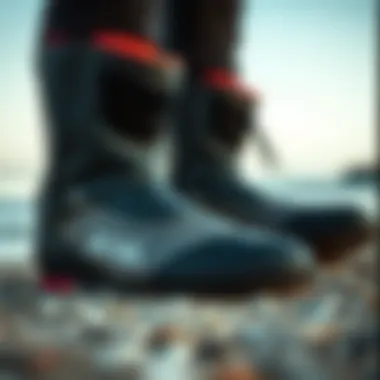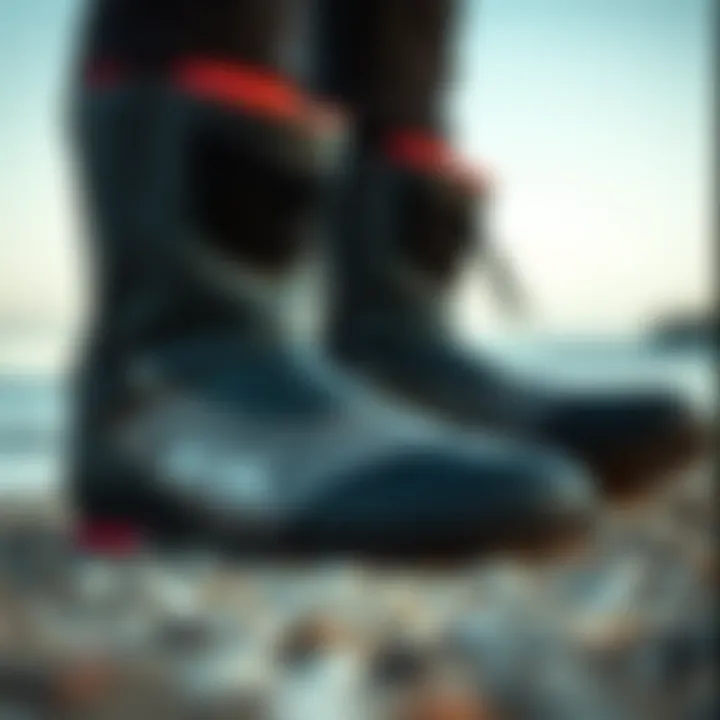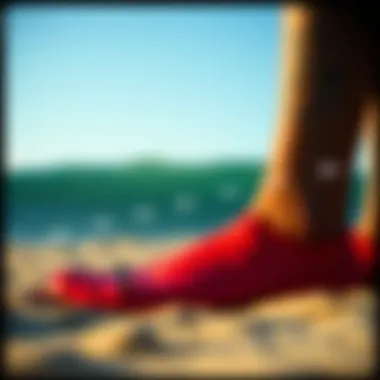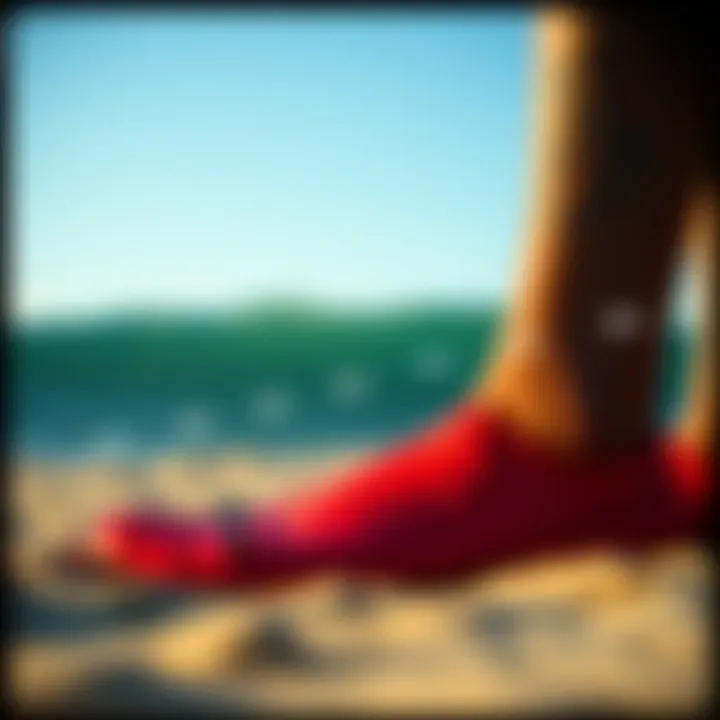Mastering the Xcel Booties Size Chart for Surfing


Intro
When you’re gliding across ocean waves, the last thing you want to worry about is your gear. However, choosing the right booties can make or break your surfing experience. Understanding the sizing chart provided by Xcel is crucial for ensuring proper fit, comfort, and performance while you take on the surf. In this guide, we'll unravel the nuances of the Xcel booties size chart and help you find the perfect footwear to ride those waves like a pro.
Surfing Techniques
Mastering the Basics
Before diving into the complexities of sizing, it’s beneficial to consider the basic techniques of surfing that necessitate the right booties. Newer surfers should pay attention to their footing. An ill-fitting boot can lead to slips, affecting balance during take-offs and turns. When evaluating fit, factors like snugness around the ankles can help prevent water from flushing in, which can cut down on distractions when you’re just starting out.
- Foot placement: Ensure your foot sits flat within the boot, securing your heel snugly to provide stability.
- Ankle support: Booties with a higher cut offer additional support, preferable for beginners still mastering standing up on the board.
Advanced Maneuvers
As surfers progress to more advanced techniques, the importance of a well-fitted boot becomes even more evident. High-performance maneuvers such as cutbacks and aerials require optimal control and flexibility. The right size ensures you can feel the board beneath you, enhancing tactility and responsiveness.
- Compression fit: This helps in executing turns smoothly without excess material creating resistance.
- Grip sole technology: Many advanced models come equipped with features ensuring maximum grip even during tricky maneuvers. Look out for brands that emphasize specialized grip technology in their designs.
Understanding the Xcel Size Chart
Diving deeper into the Xcel booties size chart, it’s essential to understand the metrics at play.
The chart typically includes:
- US Sizes: These reflect the standardized way of measuring shoe sizes in the United States.
- EU Sizes: Useful for those familiar with European measurements.
- Foot Length: Generally measured in inches or centimeters, providing a clear indication of your foot size.
- Width and Fit: Some charts might also mention the width, highlighting styles that accommodate narrower or wider feet.
Backing this up with an easier way to grasp fit:
- Opt for booties that fit snugly without causing discomfort, particularly around the toes and heels.
- If you find yourself in between sizes, it’s generally advised to go for the larger size. This helps in case of swelling or when wearing a thicker wetsuit sock.
Finale
Proper sizing shouldn’t be underestimated in its impact on surfing performance. Understanding how to interpret the Xcel booties size chart empowers surfers, ensuring that each wave is tackled with confidence and comfort. In this comprehensive guide, we've outlined not just the importance of getting it right, but also how it ties back to your overall surfing experience.
Prolusion to Xcel Booties
Understanding the significance of Xcel booties is paramount for any surfer aiming to enhance their performance and comfort in the water. Booties are not just another accessory; they play a crucial role in protecting your feet from the cold, sharp rocks, and other hazards while riding the waves. At first glance, the choice may seem straightforward, but the subtleties of fit and style can genuinely impact the overall experience.
A pair of well-fitting booties can make the difference between a thrilling surge of adrenaline and a frustrating day spent shivering on the beach. With the Xcel brand known for its innovative designs and commitment to quality, knowing how to select the correct size becomes essential. Understanding how the size chart operates can illuminate the path toward finding that perfect pair of booties designed specifically for your foot shape, intended surfing conditions, and personal preferences.
In this article, we’ll delve into the intricacies involved with Xcel booties, guiding you through how sizing influences both comfort and performance, and sharing insights to help you make an informed decision. So, whether you're a seasoned pro or a novice eager to navigate through the surf, it's crucial to grasp the nuances of this essential piece of surfing gear.
The Role of Booties in Surfing
Booties, as it turns out, play more than just a protective role. They insulate your feet against chilly waters and chilly winds, ensuring you can maintain your focus on the waves without the discomfort that comes from cold toes. Shivering in the surf not only decreases enjoyment but can also negatively affect your performance. When your feet are warm and secure, you're more prepared to tackle sudden board slips and rough landings.
Additionally, they can offer increased grip on your surfboard, especially in turbulent conditions. A slippery deck can spell disaster when you need to position yourself rapidly. With booties designed to enhance traction, you can maintain balance on the board, resulting in a smoother ride. Simply put, booties are a surfer's silent ally, powering you through even the most relentless waves.
Why Size Matters
Size is indeed king—or queen, for that matter—when it comes to surf booties. Often, surfers overlook the importance of size in favor of aesthetics or brand loyalty, but this can lead to poor experiences on the water. An ill-fitting bootie creates a range of problems, from discomfort that can distract you from enjoying your ride to more serious issues like blisters or reduced blood circulation.
Not to mention, the right fit influences your performance. Too tight a fit can restrict movement, whereas a too-loose bootie may cause slippage that hampers your ability to effectively control your board. It's as if you were attempting to walk straight while wearing two left shoes—impossible. Properly sized booties ensure you're not just grabbing the next pair off the shelf but are selecting a footwear option finely tuned to your unique foot dimensions.
Overview of the Xcel Booties Size Chart
Understanding the Xcel Booties size chart is essential for anyone looking to enhance their surfing experience. This chart serves as a vital tool, guiding surfers in selecting the appropriate size for their booties. A proper fit not only boosts comfort but directly impacts performance in the water, providing security against the elements and improving overall maneuverability on the board.
When stepping into the surf, the last thing you want to worry about is whether your booties are fitting right. An ill-fitting pair can cause discomfort or even injuries, so making sense of sizing is quite crucial. Xcel's sizing chart helps surfers navigate through their diverse offerings, simplifying the often confusing sizing landscape.
"The right gear can make or break your time in the water."
Understanding Size Labels
Diving into the specifics of how size labels work within the Xcel Booties range brings clarity to the purchasing process. Each bootie size is tagged with a unique number or letter, and deciphering this can feel like cracking a code. Xcel tends to utilize standard sizes, which vary according to foot length and width. Knowing how to interpret these labels is like having a roadmap to finding your fit.


When looking at the size chart, pay attention to both the numbered sizes—often ranging from 5 to 14—and the sizing that may include variations like ‘S’, ‘M’, ‘L’, or ‘XL’. Each label correlates to specific foot measurements. For example, someone with a foot measuring 10 inches might wear size 10 booties, but they must also consider width. This is particularly important for individuals with wider or narrower feet, as some styles will fit differently depending on overall foot shape.
Standard Sizing vs. Brand-Specific Sizing
Comparing standard sizing against brand-specific sizing reveals the subtle differences that can lead to a perfect fit. While Xcel follows a general guide, it’s important to recognize that you may not be a size 9 in every brand. When familiarizing yourself with the Xcel size chart, take into account the distinct fit philosophy that Xcel brings to the table.
Brand-specific sizing often takes into account the brand’s target audience and design ethos. For instance, Xcel has developed its sizing system through years of feedback from surfers, ensuring their booties emphasize performance. Therefore, while the size may align with a numerical value you expect, Xcel's designs could differ slightly in feel and fit due to material use and intended purpose.
As you evaluate your options, keep this key detail in mind: it’s not just about fitting the size but gauging how each design suits the contours of your foot while considering the type of surfing you plan to undertake. This approach ensures that you not only find a suitable number but also a bootie that performs brilliantly in the surf.
How to Measure Your Foot for Booties
Getting the right fit when choosing booties is absolutely crucial, especially for someone passionate about surfing. It’s all too easy to overlook this important step, thinking it’s just about grabbing a size and heading out the door. However, taking the time to measure your feet can save you a heap of trouble down the line. A well-fitted pair of booties not only enhances comfort but also boosts performance in the water. If you’re on the lookout for maximum fun while riding the waves, accurate sizing is the name of the game.
Tools Required for Measurement
Before you dive into measuring your feet, gather a few essential tools. These will make the task smoother and more precise:
- Tape Measure or Ruler: A soft measuring tape often used in sewing is ideal, but a rigid ruler can work too.
- Paper and Pen: You’ll want to have something to jot down the measurements.
- Flat Surface: A hard surface where you can easily place your foot will ensure accuracy.
- Optional: A friend to help can make life easier!
Step-by-Step Measurement Guide
Now, let’s get into the nitty-gritty of measuring. Follow these straightforward steps to get your foot size just right:
- Prepare your paper: Lay down the paper on a flat surface. It should be large enough to fit your foot comfortably.
- Trace your foot: Stand on the paper while keeping your weight evenly distributed. With a pen, carefully trace around your foot. Ensure the pen stays upright for an accurate outline.
- Measure the length: Using your tape measure or ruler, measure from the tip of your longest toe to the heel of your foot. Record this measurement in centimeters and inches for a clear reference.
- Measure the width: Now, identify the widest part of your foot. This will typically be around the ball area. Measure across this part and jot it down.
- Repeat for the other foot: It’s often the case that one foot is slightly larger than the other. Measure both, and when selecting your booties, you’ll want to go with the larger size.
By following this guide, you’ll be equipped with the knowledge to choose the right size from the Xcel booties size chart. Remember, precision is essential, so take your time and ensure your measurements are spot on. A little effort now goes a long way in ensuring your comfort and performance in the water.
Exploring Different Types of Xcel Booties
When it comes to selecting the right booties for surfing, the choice isn't just about style or color—it's about functionality and adapting to various water conditions. Xcel, a well-respected brand in the surfing community, offers different types of booties, each designed for specific purposes. Understanding these distinctions can dramatically affect comfort and performance while you’re out riding the waves.
Spring Booties
Spring booties are often favored for their balance—providing warmth without too much bulk. Typically, they offer a thickness of around 2mm to 3mm, making them ideal for transitional seasons when the water is warming up but still requires a bit of insulation. Their flexibility allows surfers to feel the board better, which is crucial for those critical maneuvers.
In terms of design, spring booties generally feature reinforced soles that enhance grip and durability. This is particularly beneficial when navigating rocky shore breaks, where you want every ounce of traction you can get.
Moreover, they often come with a combination of zipper and non-zipper options. Opting for a zippered pair may simplify putting on and taking off the booties, especially when your hands are cold—maintaining focus on your surfing instead of wrestling with stubborn footwear.
"The combo of warmth and flexibility in spring booties is like having your cake and eating it too."
Full Booties
Full booties, also known as full-foot or full-length booties, step up the game when temperatures dip further. Generally designed with thicknesses from 3mm to 5mm, these are geared towards colder waters. The complete coverage not only provides insulation but also helps in preventing foot abrasions when paddling or walking on rough terrain.
A notable advantage of full booties is their construction, which ensures water doesn't seep in easily. This feature keeps surfers warmer longer, allowing them to extend their sessions without feeling like icicles. The snug fit also aids in preserving body heat while maintaining a close contact feel with the surfboard—a necessity for swift maneuvers and balance.
Another consideration is the durability of these booties. Crafted to withstand harsh conditions, they usually have thicker traction pads that last longer against wear and tear. In the world of surfing, where every inhale of warmth counts, choosing full booties can indeed make a significant difference.
Shorty Booties
Shorty booties serve a distinct purpose within the Xcel lineup. Often utilized in warmer water, they typically cover only the foot and ankle up to the calf. Measured around 2mm to 3mm in thickness, they allow for a more liberated movement, perfect for surfers who prioritize agility over insulation. They’re a go-to choice for summer surfing when temperatures rise and water feels inviting.
Although shorty booties may seem basic, they're crafted with thoughtful design. You’ll often find reinforced toes and lightweight materials that allow for easy mobility while still delivering some degree of warmth. They strike the right chord between comfort and performance, reducing fatigue during longer sessions.
As with any booties, the fit is essential. If they’re too tight, it can lead to cramps, and if they’re too loose, you risk blisters and instability on your board. Ultimately, shorty booties provide the opportunity to enjoy longer surf sessions without feeling weighed down.
Choosing between these types of booties largely comes down to the conditions you expect to surf in and your personal comfort. As every surfer’s foot is different, it's crucial to consider how each style impacts your ride. Attention to these details can enhance your overall surfing experience.
Factors Influencing Booties Fit
When it comes to selecting the right pair of Xcel booties, understanding the factors that influence fit is essential. This understanding not only ensures comfort but also plays a significant role in performance while surfing. A poor fit can lead to discomfort, reduce agility, and ultimately dampen your surfing experience. Let's dive into three critical elements affecting booties fit: foot shape considerations, thickness of the material, and intended use conditions.
Foot Shape Considerations
Every foot has its unique nuances and dimensions, meaning no single size fits all. The shape of your foot is paramount in determining how well booties fit. For instance, some surfers might have extra-wide feet, while others may have narrow arches. Xcel booties cater to various shapes, so it’s worth focusing on these aspects:


- Width: When trying on booties, assess how snugly they hug the sides of your feet. A comfortable pair should not feel overly constrictive yet should not slip off your foot either.
- Arch Type: High arches may require more space and specific support. Many brands, including Xcel, often offer models that provide extra arch support ideal for those with high arches.
- Size Range: Xcel’s sizing chart accounts for variations in foot shape, allowing surfers to choose sizes that better match their feet. This is particularly vital for long sessions when foot fatigue can occur.
In short, finding booties that correspond to the specifics of your foot can save you from unnecessary pain during those epic surf sessions.
Thickness of Material
The thickness of the booties' material plays an equally significant role in how well they fit and perform. Different thicknesses can dictate warmth, flexibility, and overall comfort:
- Warmth vs. Flexibility: A thicker neoprene material can keep your feet warm in colder waters but can also limit the flexibility required for agile movements. Conversely, thinner materials provide greater dexterity but may expose your feet to cooler temperatures.
- Durability: Heavier materials often offer better protection against abrasions and punctures, which is crucial for rocky shore breaks. This balance between protection and comfort must be considered when choosing your booties.
- Personal Preference: Ultimately, go with what feels right for you. Some surfers might prefer thinner booties for the added flexibility, while others may prioritize warmth, especially if surfing in colder waters.
Intended Use Conditions
The conditions under which you plan to surf also have an impact on the fit and design of your booties. Different environments call for different features:
- Water Temperature: If you are surfing in chilly waters, thicker booties with better insulation are essential. Conversely, warmer waters may require lighter booties to avoid overheating.
- Surfing Style: Aggressive surfers may benefit from more flexible booties that allow for maximum movement, while those who ride on rocky beaches should consider protective features that preserve foot integrity.
- Duration of Use: If you plan on long sessions in the surf or expect variable conditions, look for booties that provide not just comfort, but also support over time.
To make the right choice, evaluate the conditions and your intended activities thoroughly. This will guide you in finding a pair that fits snugly and serves you well!
Interpreting the Size Chart
When it comes to selecting booties, navigating the size chart is crucial. The right fit can make or break your surfing experience. Misjudging your size can lead to discomfort or even affect your performance on the waves. Understanding the elements of the size chart will help you avoid these pitfalls.
The size chart itself breaks down measurements into standard metrics, making it easier to compare your specific foot measurements against various models of Xcel booties. It offers essential information that reflects not just the numerical size but also hints on how tight or snug the booties should feel. If a surfer can properly interpret the size chart, they can ensure that their booties provide optimum comfort while maintaining the required flexibility.
Standard Foot Measurements
In this context, standard foot measurements act as a cornerstone. Generally, sizes are listed using both US and metric systems, catering to a broader audience. For instance, a size 9 in US measurements could correspond to a size 42 in the European system. This duality is significant, particularly for surfers purchasing online, who may rely solely on metric measurements.
To find your standard measurement, follow these steps:
- Measure Your Foot: Stand on a piece of paper and trace the outline of your foot.
- Find the Length: Measure the distance from your heel to the tip of your longest toe.
- Consult the Size Chart: Cross-reference your measurement against the Xcel size chart.
- Consider Width: Not all feet are created equal. Depending on foot shape, you might require a broader or narrower fit than what is reflected in the size alone.
"Getting the right first step is the difference between riding the wave and getting pushed under it."
Size Comparisons Across Models
Xcel booties come in various models, each designed with specific features. However, it's not unusual to find some discrepancies in sizing between different models. For instance, a full-booty model may fit slightly different than a spring model, even if the size seems identical. Knowing this can save you from the heartache of unfit gear.
Here are the considerations for size comparisons:
- Model-Specific Designs: A full-booty typically offers more insulation, which can lead to a tighter fit compared to a shorty or spring booties. This can result in feeling a bit more cramped.
- Material Variations: Different constructions, such as neoprene thickness and elasticity, can also affect how each model fits. A thicker neoprene may feel snugger than a thinner one.
- Foot Orientation: Some models are designed to accommodate specific kinds of surfing or activities, influencing the fit as well. For instance, if you're in colder waters, you may want a tighter, warmer fit that contorts to your foot, while summer sessions may benefit from a looser fit.
In sum, comparing sizes across models is about more than just the numbers; it’s about understanding the overall fit and comfort that complements your surfing style.
Common Sizing Mistakes
When it comes to buying Xcel booties, sizing can make or break your surfing experience. A mismatch in size not just affects comfort, it can also impact your performance in the water. In a sport where precision is paramount, overlooking sizing details can lead to dissatisfaction. By addressing common sizing mistakes, surfers can enhance their experience on the waves, ensuring their booties work for them, and not against them.
Choosing the Wrong Size
One of the biggest pitfalls surf enthusiasts encounter is choosing the wrong size. A size that's too tight may restrict movement, making it difficult to paddle or balance. Conversely, going too loose can create an annoying slippage, leading to blisters or worse, a fall. Use the Xcel size chart as your guide; it’s not just a recommendation but a necessity.
Key Considerations:
- Understand your foot measurements: Know the length and width of your feet, as well as any unique features like high arches or wide toes.
- Refer to the brand’s sizing: Every brand may have different sizing. What works for one, may not work for another.
- Be flexible with fit: Remember that different booties types will fit differently. A spring bootie may feel snugger compared to its full counterpart.
By paying close attention to your size, you can avoid unneeded hassle when catching waves.
Ignoring Comfort Levels
Did you know that comfort can significantly enhance your capability to stay in the water longer? Ignoring comfort levels in your booties can lead to a jarring experience and possibly even injuries. It’s one thing to have booties that fit, but it’s an entirely different ball game if they leave you with sore feet after a long session.
Ways to Ensure Comfort:
- Try Before You Buy: If possible, wear the booties while standing or walking around. This gives a better sense of comfort than simply wearing them for a few seconds.
- Consider the Thickness: Thicker materials may provide warmth but could compromise flexible movement. Find a balance between warmth and dexterity based on your typical surfing conditions.
- Pay Attention to the Seams: Check for seams inside the booties. Sometimes the slightest irritation can turn into a major distraction during a surf session.


In the world of surfing, every ounce of comfort counts. Treat your feet to what they deserve, ensuring that your experience in the water is as seamless as your ride.
Tips for Selecting the Right Booties
Selecting the right booties is no small feat; it can significantly affect your overall surfing experiences. When it comes to the world of water sports, ensuring you're equipped with the proper gear is essential. The quest for the perfect fit often begins with understanding the nuances of the size chart and recognizing your specific needs as a surfer. The right booties not only provide warmth but also enhance comfort and stability, making them a key piece of equipment for every wave rider.
The essential elements to consider when deciding on booties include not only size but also the style that complements your surfing habits. For instance, a spring bootie may work wonders for a warm day, while a full bootie is indispensable in chillier waters. This multiplicity of choices emphasizes the importance of making an informed selection based on individual conditions and requirements.
Consulting the Size Chart Effectively
Accessing and understanding the size chart can feel overwhelming at first glance, especially with the different terminologies and measurements at play. However, it's indispensable for ensuring that you choose the correct size. Each section of the chart corresponds to specific foot measurements, so it’s crucial to be aware of your dimensions before diving into the shopping process.
One approach is to accurately measure your foot in centimeters. To achieve this, place your foot on a piece of paper and mark the longest and widest points. A ruler or measuring tape can accurately help you convert this to centimeters. Once you have this measurement, refer to the Xcel size chart so you can match your dimensions with the appropriate size.
Using the size chart as a reference helps in avoiding the common pitfall of selecting sizes based on estimates or previous purchases. Remember, sizing can vary dramatically among brands. Relying solely on your last bootie size could lead you into a trap of wrong choices, potentially resulting in discomfort during your ocean endeavors.
"Properly fitted booties can mean the difference between a great surfing experience and a wholly unpleasant one—the kind you don’t want to repeat."
Testing Fit Before a Purchase
Fit is everything. You wouldn’t buy a pair of shoes without trying them on, right? The same principle holds true for booties as well. Whenever possible, physically trying on booties can provide a clearer understanding of how they hug your feet. Look for snugness without constricting your circulation; you should be able to wiggle your toes.
If you're shopping online, consider checking stores that offer a return policy, allowing you to test them in real conditions. After trying them on, wear them in the house, or splash around in a kiddie pool for feedback on their fit and comfort level. Trying them out in controlled conditions can save you from a less than enjoyable session at the beach.
Keep in mind that foot shape has its quirks. Different models may fit differently, and even the same size can feel unique depending on the style. Therefore, be sure to consider the type of material as well; some materials may take time to break in while others maintain their shape from the first use.
Taking a comprehensive approach to selecting booties ensures that when you hit the waves, you’re fully prepared to engage with everything the ocean has to offer, allowing you to immerse yourself in the experience without distractions.
For further insights into gear maintenance, refer to National Park Service or surf community discussions on Reddit.
Maintenance and Care for Xcel Booties
Caring for your Xcel booties is not just a task; it's a crucial element in maximizing their lifespan and ensuring they perform their best when you hit the waves. Many surfers underestimate the wear and tear that booties undergo during use. Thus, understanding proper maintenance and care can make a world of difference.
The benefits of maintaining your booties go beyond simply keeping them clean. Proper care helps to preserve their insulation properties, improves comfort, and retains their structural integrity. Neglecting this essential aspect can lead to premature wear, compromised warmth, and reduced performance, making it imperative to treat your booties right.
Cleaning and Storage Recommendations
The first line of defense in bootie care is cleaning. After a day spent riding the waves, it’s easy to toss them in a corner, but that can be a costly mistake. Here are some steps that help keep them in good shape:
- Rinse Immediately: As soon as you can, rinse your booties with fresh water to remove sand, salt, and debris. These particles can cause wear over time.
- Use Mild Soap: Occasionally, use a mild soap and soft sponge to clean the inner and outer parts. Make sure to avoid harsh detergents that could damage the material.
- Don’t Machine Wash: Even if it seems easier, machine washing can wreak havoc on the booties, causing them to lose shape or insulation.
- Air Dry: Always air dry your booties away from direct sunlight. Hanging them upside down can help maintain their shape. Placing them in direct light can degrade their materials over time.
For storage, consider a cool and dry location. Avoid crumpling them in a tight corner. Instead, lay them flat or hang them up to prevent any creasing. Some surfers use a dedicated bag for their booties, which not only keeps them tidy but also prevents them from being squished under other gear.
When to Replace Your Booties
No matter how well you maintain your Xcel booties, there comes a time when they must be retired. Here are some signs that it might be time to consider a new pair:
- Visible Damage: If you notice any rips, tears, or significant wear, that’s a tell-tale sign they won’t keep you cozy in colder waters.
- Loss of Insulation: Over time, the neoprene can lose its ability to insulate properly, especially if they have been washed frequently or mis-stored.
- Uncomfortable Fit: If your booties feel tighter than usual or a bit too loose, it might not be just the fit; they might have stretched or shrunk due to age.
- Odor Issues: A persistent smell that doesn’t wash away can indicate the booties have absorbed too much moisture and bacteria, making them unsuitable for use.
Replacing old booties might feel like a hassle, but it’s worth reflecting on the comfort and performance gains a new pair can bring. Worn-out gear can lead to cold feet during your surf sessions, which no athlete wants. Therefore, keep an eye on your gear, so you can ride the waves without a hitch.
Ending: Making an Informed Purchase
In the world of surfing, where every detail counts, making an informed purchase becomes not just a mere step but a pivotal aspect of enhancing one’s performance and comfort. Choosing the right Xcel booties aligns closely with finding the perfect surfboard or wetsuit—each element contributes to the overall experience in the water. This comprehensive guide to understanding the Xcel booties size chart empowers surfers to apply the knowledge they have gleaned from the preceding sections, ensuring they get booties that fit snugly and function effectively.
Key Elements of Informed Purchases:
- Understanding the Size Chart: Knowing how to read and interpret the size chart lays the groundwork for selecting the right booties. It’s the bedrock upon which all subsequent decisions are based.
- Importance of Comfort: An appropriate fit not only maximizes comfort but also significantly enhances performance during those exhilarating rides on the waves. Uncomfortable booties can distract, detract from focus, and lead to a less enjoyable experience.
- Considering Individual Needs: Every surfer has specific preferences and needs influenced by foot shape, surfing style, and local conditions. This guide encourages readers to factor in these nuances when evaluating their options.
- Awareness of Common Pitfalls: Recognizing typical sizing mistakes and how to avoid them can save surfers from frustration during selection and ensure they choose booties that complement their surfing endeavors effectively.
"The right equipment makes all the difference between a good surf session and a great one."
By taking the insights and practical advice from this article into account, buyers are better prepared to navigate the selection process with confidence, making choices that truly align with their surfing aspirations.
Recap of Key Points
- Proper sizing is crucial for maximizing comfort and performance while surfing.
- Understanding the Xcel booties size chart’s nuances enables better decision-making.
- Specific foot measurements and factors like material thickness influence fit.
- Avoiding common mistakes in sizing and priorities such as comfort can significantly enhance the surfing experience.
Next Steps for the Buyer
- Review the Size Chart Again: Take a few moments to reassess the size chart with personal foot measurements in mind. Refer back to the measuring guide if necessary to double-check dimensions.
- Consider Intended Use: Reflect on your surfing conditions—whether you're hitting local beach breaks or traveling to colder climates, choose booties that fit your needs.
- Test Before Purchase: If possible, try on booties in-store or buy from a retailer that offers a good return policy to ensure you can test them in real conditions.
- Look for Reviews: Seek feedback from other surfers regarding their experiences with Xcel booties. First-hand insights can often shed light on practical performance aspects.
- Stay Informed: Keep abreast of new developments in surf gear—brands like Xcel frequently release updates and innovations that could enhance your surfing adventures.
By following these steps, surfers will not only make informed purchases but can also enhance their overall surfing journey, reaping benefits that come from careful consideration and a focus on quality.















